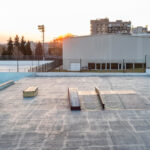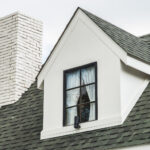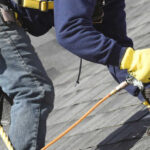Imagine the sense of relief and security you feel as you survey your newly installed roof, reflecting on the investment you’ve made to protect your home. This sturdy shelter is meant to withstand weather changes, providing a safe haven for you and your family. But what happens when your fresh fortress starts betraying your trust? When droplets of water make their unwelcome appearance, seeping into your interior spaces?
Yes, new roofs can leak too!
While it’s a scenario no homeowner wants to face, it’s not unheard of. Leaks can spring up even in the most recently installed roofs, causing a fair amount of frustration and panic. But remember, it’s a situation that can be tackled efficiently with the right information and professional help.
There are a few reasons why a new roof might start leaking. From the quality of materials used and installation practices to weather events, a variety of factors could be at play. Identifying the cause is the first step towards resolving the problem and regaining your peace of mind.
Let’s delve deeper into the common causes of new roof leaks, where they’re most likely to occur, what steps to take if you’re dealing with one, and how best to prevent them in the future.
The Most Common Causes of New Roof Leaks
Understanding why new roofs may leak enables you to make informed decisions about the materials you choose, the company you entrust with installation, and how to maintain your roof post-installation.
While there can be several causes behind leaks in new roofs, some tend to surface more frequently than others.
Improper installation: Often, new roof leaks can be traced back to errors made during installation. This can be due to a variety of factors such as inadequate sealing, misalignment of roofing materials, or not following the manufacturer’s installation guidelines. For instance, gaps or tears in the roofing material, improperly installed flashing, or unsealed nail holes can create points of entry for water. These leaks can range from minor drips to substantial water intrusion, causing damage to your home’s interior and leading to potential mold growth or structural issues.
These concerns underscore the importance of entrusting your roof installation to a top-notch professional. If you’re in Virginia, for example, consider a company renowned for its quality workmanship – like United Roofing & Exteriors, hailed as the best roofing company Virginia has to offer.
Faulty materials: In some cases, the roofing materials themselves might be the source of the problem. Defective shingles, underlayment, or flashing can fail to provide the necessary water barrier, leading to leaks. While these cases are less common, they tend to occur when homeowners opt for the cheapest materials available to cut down on installation costs. Unfortunately, these cost savings can be short-lived if the materials fail prematurely and require repair or replacement.
Weather damage: Even the newest of roofs aren’t immune to the power of Mother Nature. Severe weather events such as hailstorms, strong winds, or heavy rain can damage the roofing materials or displace them, leading to potential leaks. Hail can cause cracks or punctures in shingles, while high winds can rip them off entirely. Rain, in turn, can exploit any vulnerability in your roof, seeping through cracks and openings.
Post-storm inspection becomes crucial in these circumstances, allowing for quick identification and repair of any damages. This proactive approach can prevent a minor issue from developing into a major, more costly problem.
Where Do Roofs Leak the Most?
When we’re discussing potential leak sites on your roof, it’s essential to understand that leaks don’t occur randomly. There are specific areas more prone to leaks, mainly due to their structural design or the materials used.
Chimney: One of the most common places you’ll find roof leaks is around the chimney. The intersection between the chimney and the roof is sealed with a material known as flashing. This component is designed to create a water-tight barrier, but if it’s installed incorrectly or deteriorates over time, water can find its way in.
Windows and Skylights: Similar to chimneys, windows and skylights represent a break in the continuous surface of the roof. They also rely on flashing for a leak-proof seal. Errors in flashing installation, material failure, or even the sealant around the window or skylight wearing down, can lead to leaks.
Vent Pipes: Your roof houses several vent pipes for different systems in your home, such as the HVAC or plumbing. These pipes protrude through the roof and, as with chimneys and windows, are sealed with flashing. Incorrectly installed or damaged flashing around these pipes can give water an entry point into your home.
Missing Shingles: Shingles serve as the outer layer of protection on your roof, shielding it from the elements. If one or more shingles are missing, this exposes the underlayment and decking, offering an easy path for water to seep into your home. Shingles can go missing due to heavy winds, physical impact, or even poor installation.
By recognizing these vulnerable areas on your roof, you can give them extra attention during routine inspections or after severe weather events. This proactive approach can help you detect and fix any problems early on, potentially saving you from more extensive, costly damage.
What to Do If Your New Roof Leaks
If you spot a leak, your immediate response should be to identify its source. Depending on the cause of the leak, you might have to contact the roofing contractor for improper installation, the manufacturer for faulty materials, or your insurance company for weather-related damage.
Knowing how to respond can make a significant difference in minimizing the damage and resolving the issue efficiently.
Identify the Source: As soon as you spot a leak, the first order of business is to identify its source. You can often trace the leak back to a vulnerable area on the roof, such as around the chimney, windows, skylights, or vent pipes, or where shingles are missing. Start by investigating these common leak-prone areas. You might be able to see visible signs of damage like displaced shingles, or loosened or corroded flashing.
Document the Damage: Once you’ve identified the source, document the damage. Take photographs of the compromised area and any resulting damage within your home, like water stains on the ceiling. This record will be valuable when discussing repairs with your contractor or filing an insurance claim.
Contact the Right Party: Depending on the cause of the leak, you’ll need to reach out to different parties:
a) Roofing Contractor: If the leak results from improper installation, you should contact the roofing contractor who installed the roof. A reputable contractor will honor their warranty, addressing and repairing the problem free of charge.
b) Manufacturer: If the leak is due to faulty materials, the manufacturer of the roofing materials should be your next call. They may replace the defective materials free of charge or compensate for the damages, as long as the materials are under warranty.
c) Insurance Company: For leaks caused by weather damage, reach out to your homeowner’s insurance company. Depending on your policy, they may cover the cost of repairs or replacement.
Arrange for Immediate Repair: To prevent further damage, arrange for the necessary repairs as soon as possible. This could mean patching a hole, replacing faulty materials, or adjusting improperly installed components.
Addressing a leak promptly and correctly can help limit the damage to your home and potentially save you significant repair costs in the future.
How to Prevent New Roof Leaks?
Hiring a reputable roofing contractor like United Roofing & Exteriors is the best way to prevent leaks. As the best roofing company Virginia trusts, we ensure correct installation and use high-quality materials. Regular roof inspections and prompt repair of any identified damage also go a long way in leak prevention.
Although new roofs can leak, this does not always reflect poor workmanship. Most of the common causes are preventable, and early detection is key. If you find your new roof is leaking, start by identifying the source, and take the necessary steps to address it.
Remember, choosing a reliable roofing contractor like United Roofing & Exteriors can make all the difference. So whether you’re in Virginia, let us help ensure your roof is leak-free and lasts for many years.
Are you worried about a potential leak in your new roof? Contact United Roofing & Exteriors today for a roofing inspection and repair. Reach us in Virginia at 571-587-2941. We’re here to help protect your home.






